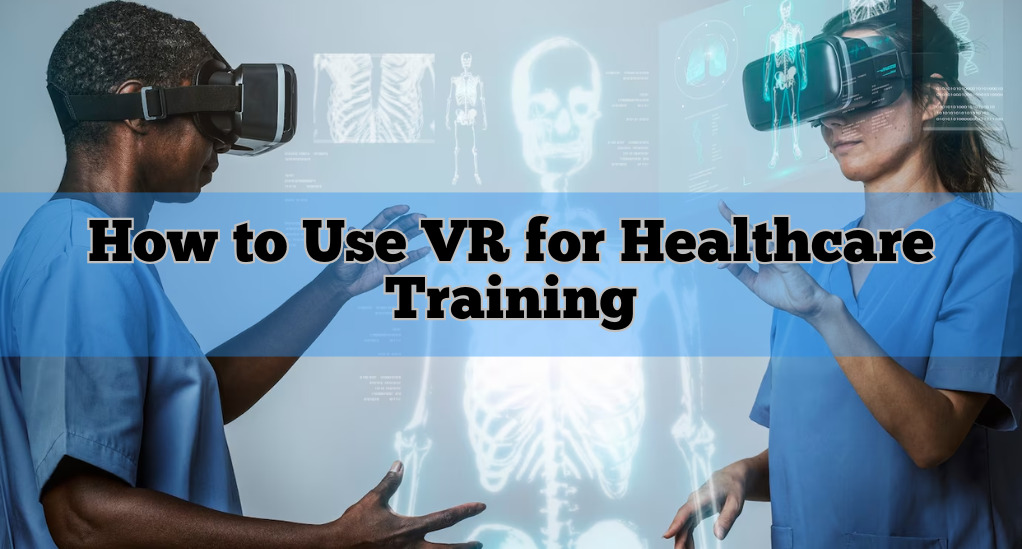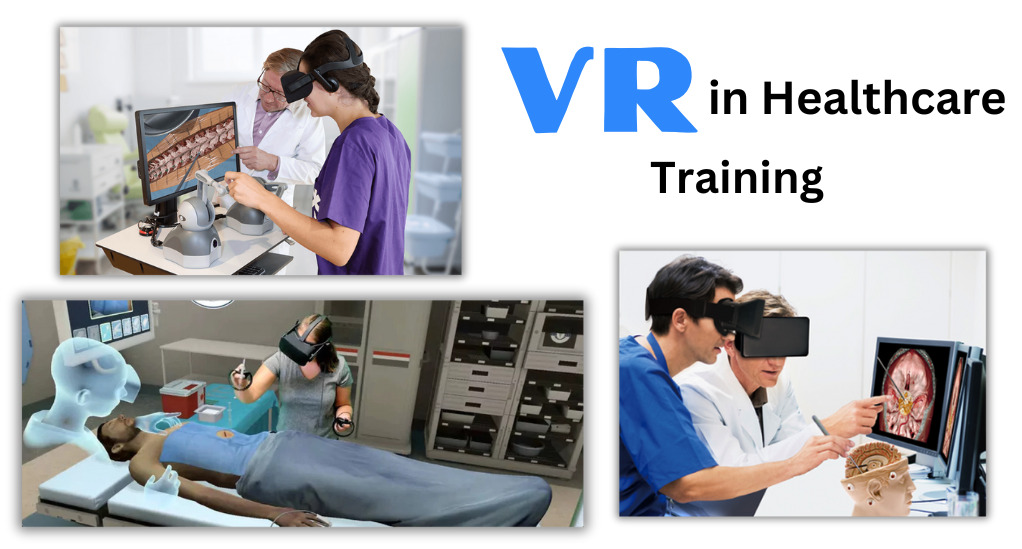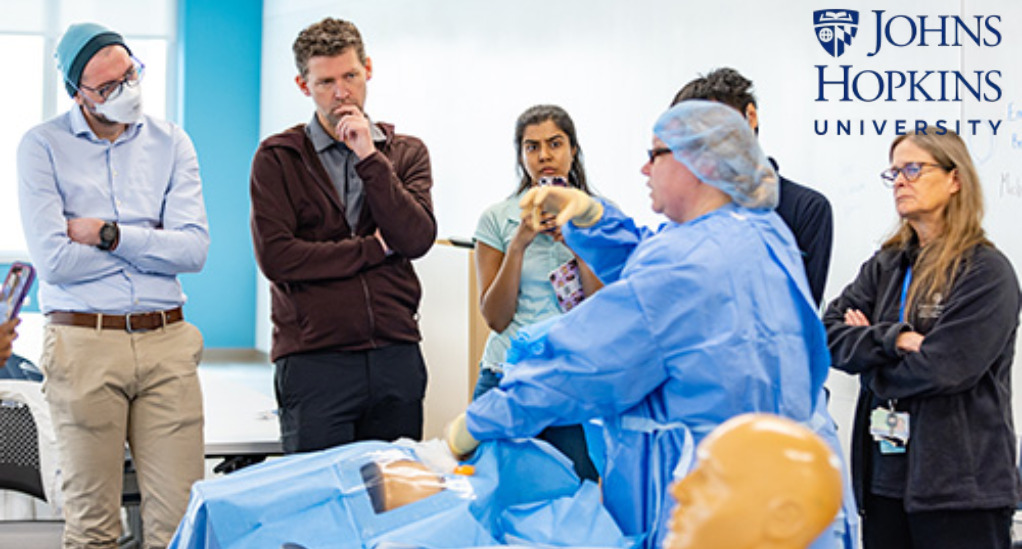
How to Use VR for Healthcare Training: Revolutionizing Medical Education
In the realm of medical education, the digital age has ushered in a wave of transformative technologies, with Virtual Reality (VR) standing at the forefront. As the healthcare sector continually seeks innovative methods to enhance training and patient care, VR emerges as a game-changer, offering immersive, interactive, and highly effective learning experiences.
The Rise of VR in Healthcare Training

The concept of VR is not new; it has been around for decades. However, its application in healthcare training has seen a significant surge in recent years. Traditional medical training often relied on cadavers, textbooks, and live demonstrations. While these methods have their merits, they come with limitations, such as the inability to replicate certain scenarios or provide real-time feedback.
With the ability to simulate a vast range of medical scenarios, from intricate surgeries to patient interactions, VR offers an unparalleled depth of immersive learning. Trainees can now step into a virtual operating room, practice surgical procedures, and even interact with virtual patients, all in a controlled and risk-free environment.
The Potential Impact on Medical Education and Patient Care
The implications of VR in healthcare training extend beyond just the educational aspect. By providing a hands-on, immersive experience, VR ensures that medical professionals are better prepared for real-world scenarios. This not only enhances their skill set but also boosts their confidence, leading to improved patient outcomes.
Moreover, the flexibility of VR means that training can be tailored to individual needs. For instance, a trainee struggling with a particular surgical procedure can repeatedly practice it in the virtual realm until they achieve proficiency.
| Advantages of VR in Healthcare Training | Traditional Training Limitations |
|---|---|
| Immersive and interactive experiences | Limited hands-on experiences |
| Risk-free environment for practice | Potential risks with live patients |
| Tailored training modules | One-size-fits-all approach |
| Real-time feedback and assessment | Delayed feedback |
The Evolution of VR in Medical Training
The journey of VR in medical training is a testament to the relentless pursuit of excellence in the healthcare sector. From its nascent stages as a novel concept to its current status as a pivotal tool in medical education, VR’s evolution is both fascinating and revolutionary.
Historical Context and the Shift from Traditional Methods
The 1980s and 1990s saw the first inklings of VR, primarily in the gaming and entertainment sectors. However, visionary medical educators soon recognized its potential. Initial applications were rudimentary, focusing on basic anatomy lessons and simple procedures. But as technology advanced, so did the complexity and depth of VR simulations.
Traditional methods, while invaluable, had their constraints. Cadaver-based learning, for instance, offered a finite resource, and real-patient scenarios always carried inherent risks. VR bridged these gaps, providing an infinite realm where mistakes were learning opportunities, not life-threatening events.
The Projected Growth of the AR and VR Market in Healthcare
The global acceptance and integration of VR in medical training have led to substantial market growth. According to a report by Research and Markets, the AR and VR sector in healthcare is projected to witness a 22.5 percent compound annual growth rate from 2023 to 2027. This surge is not just indicative of its popularity but also its efficacy as a training tool.
Several factors contribute to this growth:
- Technological Advancements: As VR technology becomes more sophisticated, its applications in healthcare training expand, covering a broader range of scenarios and offering more realistic experiences.
- Cost-Effectiveness: While the initial investment in VR equipment might seem steep, in the long run, it proves cost-effective. The repeatability of VR scenarios eliminates the recurring costs associated with traditional methods, such as procuring cadavers.
- Global Collaboration: VR allows for real-time collaboration between medical professionals worldwide. A surgeon in the US can virtually collaborate with a peer in Asia, discussing complex cases or sharing expertise.
Embracing the Digital Future
The integration of VR in medical training signifies a broader shift towards digital transformation in healthcare. As we stand on the cusp of this new era, it’s evident that VR, along with other emerging technologies, will play a pivotal role in shaping the future of medical education. The next challenge lies in ensuring equitable access to these tools, fostering a global community of well-trained, tech-savvy healthcare professionals ready to lead the charge into the future.
Understanding the Basics: AR, VR, and XR
In the ever-evolving world of technology, it’s crucial to grasp the foundational concepts that drive the innovations in healthcare training. Augmented Reality (AR), Virtual Reality (VR), and Extended Reality (XR) are three such pivotal technologies that, while interconnected, offer distinct experiences and applications.
Augmented Reality (AR)
At its core, AR is the enhancement of the real world with digital elements. Using devices like smartphones or AR glasses, users can see computer-generated images superimposed on their actual environment. In medical training, this could mean overlaying a digital representation of the vascular system on a live patient, allowing students to visualize internal structures without making an incision.
Key Applications in Healthcare:
- Surgical Planning: Surgeons can use AR to visualize the surgical area, understanding potential complications before making the first cut.
- Medical Imaging: Radiologists can view 3D reconstructions of MRIs or X-rays, offering a more comprehensive understanding of the patient’s condition.
Virtual Reality (VR)
VR immerses the user in a completely digital environment, shutting out the real world. This full immersion is achieved using VR headsets and, in some cases, tactile feedback devices. For medical students, VR can simulate surgeries, patient interactions, or even the experience of a patient suffering from specific symptoms.
Key Applications in Healthcare:
- Skill Development: Surgeons can practice complex procedures in a risk-free virtual environment, honing their skills before performing on real patients.
- Patient Education: Patients can use VR to understand their medical conditions better, visualizing the ailment and the proposed treatments.
Extended Reality (XR)
XR is an umbrella term that encompasses all immersive technologies, including AR, VR, and everything in between. It represents the full spectrum of experiences, from complete immersion in a digital world to the subtle enhancement of the real world with digital elements.
Key Applications in Healthcare:
- Remote Collaboration: Medical professionals from around the world can collaborate in a shared virtual space, discussing cases, and sharing expertise.
- Rehabilitation: Patients recovering from traumatic injuries can use XR for physical therapy, engaging in virtual exercises tailored to their recovery needs.
The Convergence of Realities
As AR, VR, and XR technologies continue to advance, their distinctions may blur, leading to integrated applications that draw from the strengths of each. Imagine a world where a surgeon, using an XR headset, can perform a surgery with real-time guidance from experts worldwide, overlaying digital information on the patient while immersed in a virtual collaborative space. This convergence promises not only to revolutionize medical training but also to redefine the very boundaries of healthcare delivery.
Case Study: Johns Hopkins’ Approach to VR Training

Johns Hopkins, a name synonymous with medical excellence, has been at the forefront of integrating innovative technologies into its curriculum. Their adoption of VR for medical training offers valuable insights into the practical applications and benefits of this transformative tool.
A Multi-Faceted Implementation
The Johns Hopkins School of Nursing has embraced VR training across its spectrum, from doctoral studies to prelicensure nursing. This comprehensive approach ensures that every student, regardless of their level, benefits from the immersive experiences that VR offers.
Key Training Areas:
- Resuscitation: Simulating emergency scenarios where timely intervention can mean the difference between life and death.
- Anaphylactic Reactions: Preparing students for sudden, severe allergic reactions, ensuring they can act swiftly and confidently.
- Postsurgical Management: Offering insights into post-operative care, monitoring, and potential complications.
- Acute-Care Management: Handling sudden and severe medical conditions, from heart attacks to respiratory failures.
- Pediatric Critical Care: Specialized training focused on the unique challenges of treating critically ill children.
The Power of Collaboration
One of the standout features of Johns Hopkins’ VR approach is its emphasis on collaborative learning. Kristen Brown, assistant professor at the Johns Hopkins School of Nursing, has been instrumental in developing multiplayer VR studies. These studies involve medical and nursing trainees engaging in practice scenarios that can accommodate up to 100 learners simultaneously. Such collaborative environments foster teamwork, communication, and a multi-disciplinary approach to patient care.
The Technical Backbone
Driving this VR initiative is a robust technical setup. The institution employs Oculus headsets paired with high-performance Alienware computers from Dell Technologies. While the tactile feedback from hand haptics enhances the immersive experience, the real game-changer, according to Brown, is the cognitive decision-making aspect. The VR modules are designed to adapt in real-time to students’ actions, ensuring a dynamic learning environment. This adaptability is powered by artificial intelligence functionalities that adjust scenarios based on students’ decisions, providing a tailored learning experience.
A Vision for the Future
Johns Hopkins’ foray into VR training is more than just a technological experiment; it’s a vision for the future of medical education. By creating a dynamic, adaptive, and collaborative learning environment, they are not only equipping their students with skills but also with the confidence to make critical decisions in high-pressure scenarios. As VR technology continues to evolve, institutions like Johns Hopkins will undoubtedly lead the charge, shaping the next generation of healthcare professionals.
Orthopedic Training with VR: Insights from Massachusetts General Hospital
Massachusetts General Hospital (MGH), a renowned name in the medical world, has been pioneering advancements in various medical fields. Their venture into the realm of VR for orthopedic training provides a glimpse into the transformative potential of this technology in specialized medical disciplines.
PrecisionOS: A Leap Forward
At the heart of MGH’s VR initiative for orthopedic training is a system known as PrecisionOS. Dr. Augustus D. Mazzocca, the chief of the division of sports medicine at MGH, has been instrumental in integrating this system to augment orthopedic education. PrecisionOS offers a realistic environment, allowing students to practice intricate procedures without the constraints of traditional methods.
Key Features of PrecisionOS:
- Real-time Feedback: Unlike cadaver-based training, where feedback can be delayed, PrecisionOS provides immediate insights, allowing students to learn and adapt in real-time.
- Collaborative Viewing: Educators can connect the VR glasses to a laptop, enabling them to see exactly what the trainee is observing and performing. This shared view facilitates better instruction and guidance.
The Multifaceted Benefits of VR in Orthopedics
The adoption of VR in orthopedic training at MGH has brought forth several benefits:
- Repeated Practice: VR allows students to practice a procedure multiple times, ensuring mastery. This repeatability contrasts with traditional methods like cadaver labs, where exercises might be limited.
- Enhanced Spatial Understanding: Orthopedics often requires a deep understanding of spatial relationships within the human body. VR, with its 3D visualization, offers students a unique perspective, aiding in procedures that require precise placements, like pinning fractures.
- Procedure Familiarization: From knee replacements to shoulder reconstructions, students can familiarize themselves with a wide array of procedures without the need for live patients.
The Road Ahead
While Dr. Mazzocca acknowledges that VR in orthopedics is still in its early stages, he is optimistic about its future. He envisions a world where VR is a staple in orthopedic training, covering all areas, from hip fractures to ACL reconstructions. The goal is not just to enhance the training process but to ensure that the next generation of orthopedic surgeons is equipped with the skills, confidence, and expertise to deliver unparalleled patient care.
AR in Nursing: A Deep Dive into UCF’s Implementation
The University of Central Florida (UCF), a leading institution in healthcare education, has taken significant strides in integrating Augmented Reality (AR) and Virtual Reality (VR) into its nursing curriculum. Their innovative approach offers a fresh perspective on how immersive technologies can reshape nursing education and practice.
A Holistic Approach to Learning
The UCF College of Nursing has been proactive in implementing both AR and VR for nurses and nurse practitioners. Mindi Anderson, interim associate dean for simulation and immersive learning at UCF, emphasizes the holistic learning experience these technologies offer. Beyond just skill acquisition, AR and VR provide a deeper understanding of the human body, its anatomy, and the underlying pathophysiology of various conditions.
Key Insights from UCF’s Implementation:
- Inside the Human Body: One of the standout features of UCF’s AR and VR modules is the ability to virtually “walk inside” the human body. This immersive experience allows students to visualize and understand intricate physiological processes, from blood flow in arteries to neural pathways in the brain.
- Real-time Pathophysiology: Students can witness the progression of medical conditions in real-time. For instance, they can observe the cascade of events during a heart attack or the cerebral impact of a stroke. This real-time visualization aids in comprehension and retention.
Practical Applications in Nursing Education
UCF’s AR and VR modules are not just theoretical; they have tangible applications in practical nursing scenarios:
- Holographic Patients: Using AR, students can visualize a holographic patient in a real-world setting. This fusion of the digital and physical worlds allows for a more comprehensive patient assessment, from observing virtual vitals to understanding underlying conditions.
- Simulated Medical Scenarios: VR offers a controlled environment where students can practice various medical interventions, from administering medications to performing CPR. These simulations can be repeated, ensuring mastery and confidence.
The Future Vision: Blending Realities for Enhanced Care
Anderson envisions a future where AR and VR are seamlessly integrated into the nursing curriculum. From classroom lectures to hands-on clinical practice, these technologies will play a pivotal role in shaping the next generation of nurses. The goal is to produce healthcare professionals who are not only skilled but also empathetic, intuitive, and equipped to handle the challenges of modern-day nursing.
Best Practices for Implementing AR and VR in Healthcare Training
As institutions globally recognize the transformative potential of AR and VR in healthcare training, it’s crucial to understand the best practices for their implementation. Ensuring a seamless integration of these technologies not only maximizes their benefits but also ensures a positive and productive learning experience for students.
Emphasizing Multiplayer Scenarios and Team-Based Training
One of the standout features of AR and VR is the ability to create collaborative environments. Multiplayer scenarios, where multiple students can engage in a shared virtual space, foster teamwork and communication – two critical components in healthcare.
Key Takeaways:
- Shared Learning: Multiplayer VR allows students to learn from each other, observing different approaches to the same scenario.
- Enhanced Communication: Collaborative VR scenarios emphasize the importance of clear communication, mirroring real-world healthcare settings where teamwork is paramount.
Repeated Practice in a Controlled Environment
The virtual realm of AR and VR offers a risk-free environment where mistakes are learning opportunities. Institutions should leverage this by encouraging students to repeatedly practice specific scenarios, ensuring mastery.
Benefits:
- Skill Refinement: Repeated practice allows students to refine their skills, ensuring precision and confidence in real-world scenarios.
- Feedback Loop: The immediate feedback provided in VR scenarios aids in continuous improvement, allowing students to adapt and evolve.
Real-time Decision Making
AR and VR scenarios should be dynamic, adapting in real-time based on students’ decisions. This adaptability ensures that students are not just following a script but are actively making decisions, mirroring the unpredictability of real-world medical scenarios.
Implementation Tips:
- Scenario Variability: Ensure that VR modules have multiple outcomes based on student actions, emphasizing the consequences of their decisions.
- Cognitive Challenges: Integrate scenarios that challenge students cognitively, pushing them to think critically and make informed decisions.
Continuous Updates and Technological Advancements
The world of AR and VR is continuously evolving. Institutions should ensure that their modules are updated regularly, incorporating the latest technological advancements and medical knowledge.
Recommendations:
- Regular Training for Educators: Ensure that educators are well-versed with the latest AR and VR tools, enabling them to guide students effectively.
- Feedback Integration: Actively seek feedback from students and educators, using it to refine and enhance the AR and VR modules.
Conclusion
The integration of VR into healthcare training signifies a monumental shift in medical education, blending cutting-edge technology with pedagogical excellence. Institutions worldwide have showcased the transformative potential of these tools, not only enhancing learning experiences but also fostering global collaboration, democratizing education, and ensuring superior patient outcomes. As we look to the future, the convergence of AR, VR, AI, and other emerging technologies promises a limitless horizon for medical training. This evolution embodies humanity’s relentless pursuit of knowledge and our unwavering commitment to elevating healthcare standards globally.


Leave a Reply